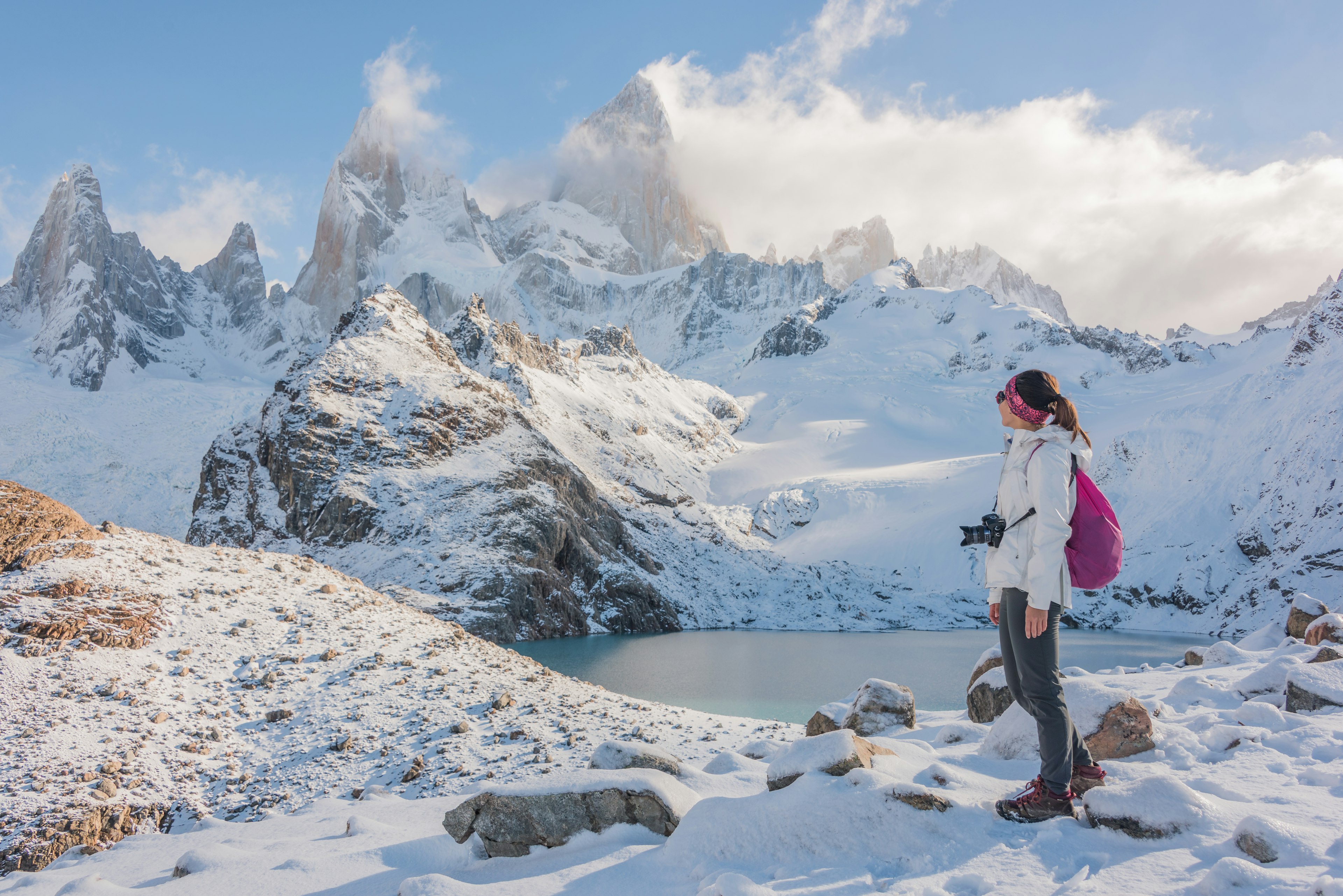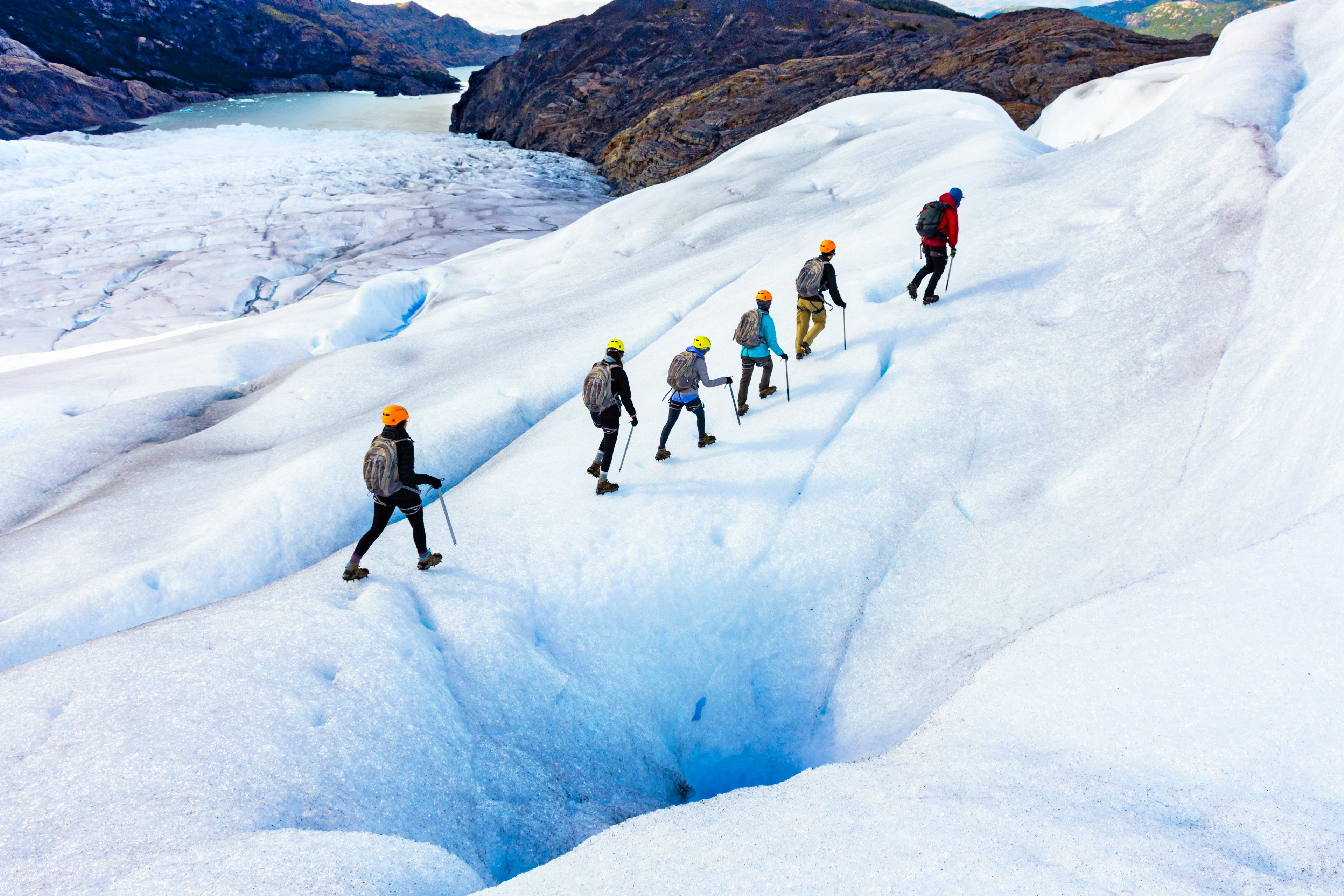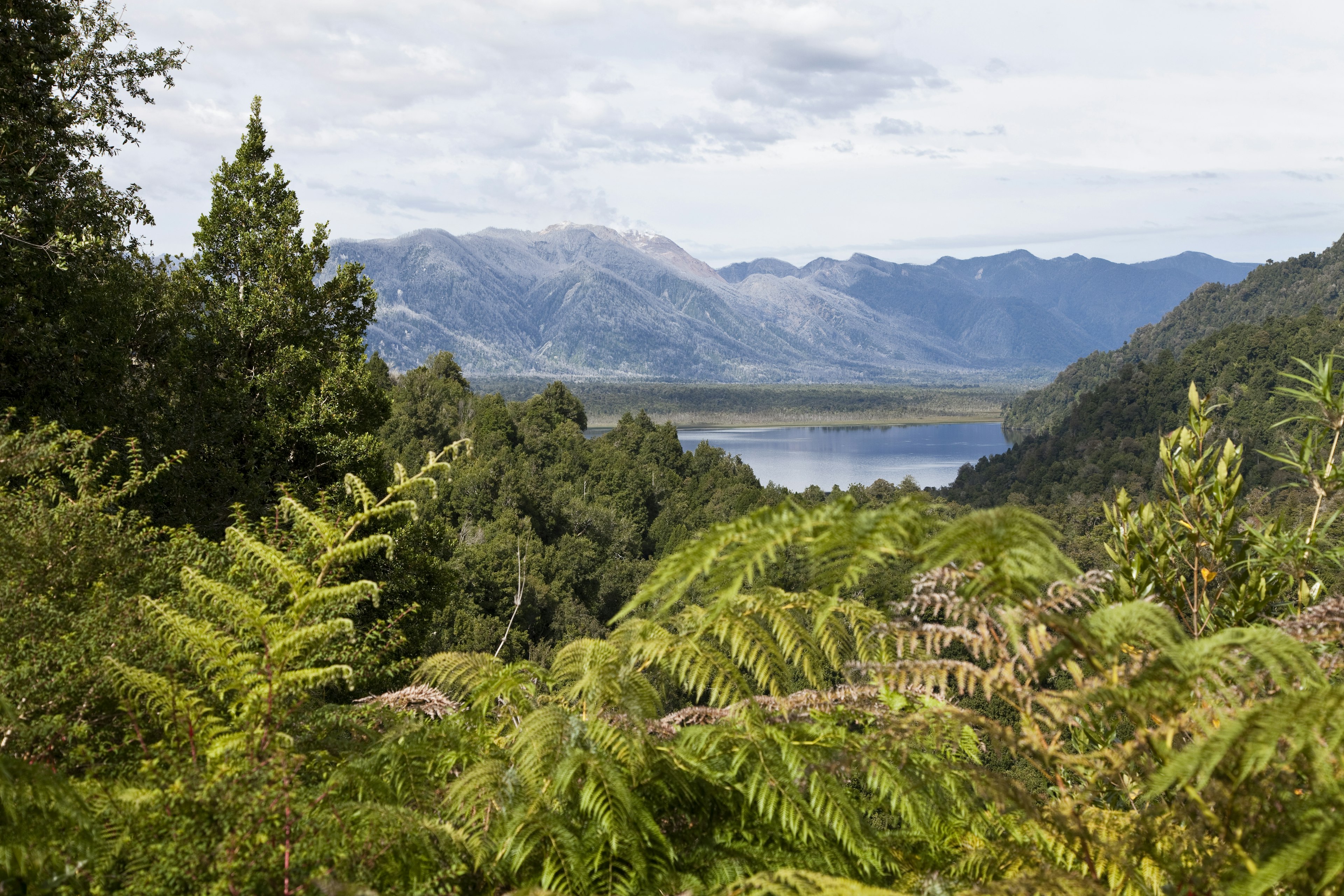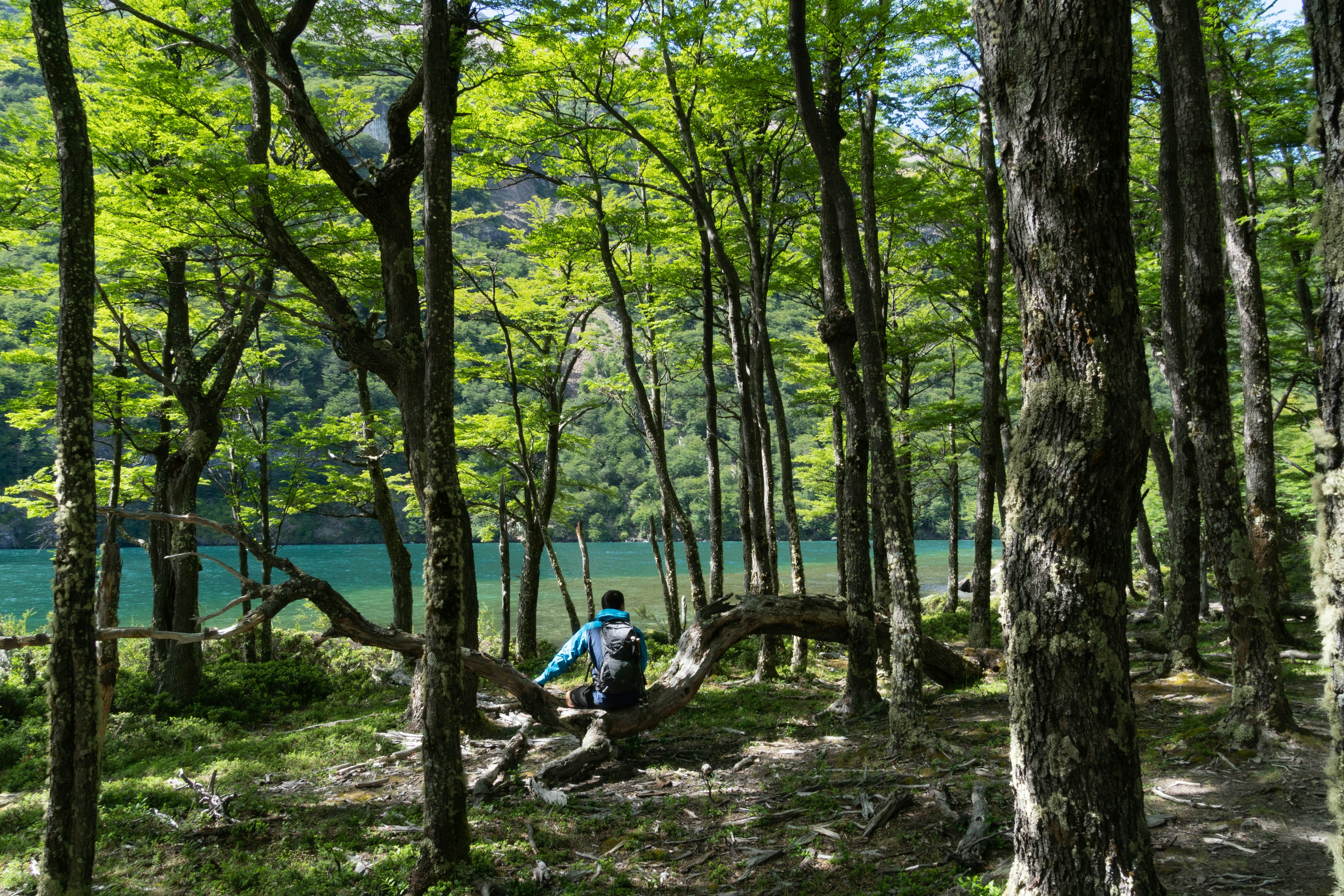Crisscrossed by glacial rivers and streams, alternately covered in scrubland and ancient woodlands, and dotted with myriad ice-melt lakes whose surfaces range from pale blue to navy, Patagonia offers an extraordinary way to encounter nature at its rawest.
Covering a massive chunk of southern Chile and Argentina, the region is almost synonymous with adventure. Whether you’re looking to rough it on multi-day treks through pristine wilderness, hike from hut to hut in epic national parks, exert yourself on varied day treks before returning to the comfort of your boutique guesthouse, or just stretch your legs beneath the shade of Chile’s and Argentina’s oldest trees while road-tripping along Chile’s Carretera Austral, Patagonia has a great deal to offer.
Keep in mind that trekking in Patagonia and Tierra del Fuego is largely confined to the peak and shoulder seasons of November to late March. If you want to hike off the beaten track, make sure you’ve left word with someone about proposed route, take a tent sturdy enough to withstand the famous Patagonian wind (called La Escoba de Dios, or God’s Broom) and all the supplies you’ll need. During any hike, all-weather gear is a must (in Patagonia, it’s normal to experience four seasons in one day – or even one hour). Accommodations must be booked many weeks in advance for the December-to-February high season.
With those details out of the way, let’s get to the 12 best hikes in Patagonia.
1. Laguna de Los Tres, Parque Nacional Los Glaciares (Argentina)
Best for scenery and a sense of accomplishment
15.5 miles (25km) round trip, 8–10 hours, moderate
Only accessible on less windy days, this is the most scenic and challenging of all the day hikes around southern Argentina’s compact trekking capital of El Chaltén. The well-marked trail ascends through ñire (small southern beech) woodlands from the north end of El Chaltén’s main street, past turquoise Laguna Capri and across boggy terrain to Camapamento Poincenot, popular with climbers. A steep, exposed trail zigzags up the mountain side to the glacial lagoon, where you get excellent bonus views of Cerro Fitz Roy (11171ft/3405m), the mountain resembling a jagged tooth. Dip your feet in the water – but don’t keep them there, as you’ll quickly lose feeling.

2. The W Trek, Torres del Paine National Park (Chile)
Best overnight option in Torres del Paine
46 miles (74km) one way, 3–5 days, moderate
The shorter of the two multi-day treks that Chile’s iconic Torres del Paine National Park is known for, this route is shaped like the letter that gives it its name. To start off, you’ll take a boat across Lake Pehoé, then hike through woodland along the banks of Lake Grey to the icy monolith of Glacier Grey before retracing your steps. You then pass along the shores of glacial Lake Nordenskjöld, and climb steeply up the French Valley for an up-close look at Los Cuernos, the park’s bell-shaped mountain range. A final stint through scrubland, across hills and up the Ascencio River valley brings you to the trident peaks of Las Torres.
You can either camp en route at designated campsites, go from refugio (bunk hut) to refugio, or even glamp along the way. Due to Torres del Paine’s immense popularity, all accommodations and camping spots have to be prebooked months in advance. The W is best hiked west to east if you’re camping, so that you’ll have used up most supplies before tackling the steep ascent to the granite towers.
3. Lagunas Altas Trail, Parque Nacional Patagonia (Chile)
Best for easy access
14.2 miles (23km) loop, 8 hours, moderate
Near the entrance to the park, the most easily accessible trail in Parque Nacional Patagonia is an invigorating leg-stretcher that’s stupendously scenic. Climbing a forested ridge from the Westwind Campsite near the visitors center, the trail passes several tiny glacial meltwater lakes across open terrain. You’ll find that your jaw drops open more than once during the hike at the all-encompassing views of the northern Patagonian ice field, Chacabuco Valley and the Jeinimeni Mountains en route.
4. Volcan Chaitén Crater Trail, Parque Nacional Pumalín Douglas R. Tompkins (Chile)
Best for an all-encompassing view
2.7 miles (4.4km) round trip, 5 hours, moderate
In 2008, the eponymous volcano in northern Patagonia staged a surprise eruption and buried half the town of Chaitén under mud and ash. This relatively steep 5-hour round-trip trek starts near Puente Los Gigos, off the Carretera Austral, north of the now-rebuilt town. Following the eruption path of the volcano, the trail gets progressively more barren the higher you get. Your reward at the top is the all-encompassing view of the still-smoking crater and the surrounding forest.

5. Laguna Torre, Parque Nacional Los Glaciares (Argentina)
Best for seeing icebergs and glaciers
13.6 miles (22km) roundtrip, 6–8 hours, moderate
Another excellent day hike from El Chaltén, this trail takes you from the south of town through the Fitz Roy river valley. Passing a small hydroelectric station, you’ll climb through lenga and ñire woods to reach the Mirador Laguna Torre, with views of glaciers beneath the Adela mountain range, Cerro Torre, Mt Fitz Roy and the granite “needles” popular with rock climbers. Crossing an alluvial plain bisected by the glacial Fitz Roy river, you’ll pass the partially sheltered De Agostini campsite before skirting the iceberg-filled Laguna Torre to reach Mirador Maestri, overlooking Glacier Grande.

6. The Circuit, Torres del Paine National Park (Chile)
Best for a long-distance trek
68 miles (110km) loop, 6–10 days, moderate
If you have more time to spare, tackle the longest trek in Torres del Paine in a clockwise direction. Incorporating the W, this spectacular loop gives you unique views of the backs of Los Cuernos and Las Torres – the park’s two mountain ranges – from remote backcountry. As you climb partially forested hills en route from the Serón campsite to the Dickson campsite and refugio, you’ll enjoy views of Lake Paine and Lake Dickson along the way, and take boardwalks across boggy sections. This first half of the hike is where you’re most likely to come face to face with one of the park’s many mountain lions.
From Refugio Dickson, you’ll enter dense southern forest, with thickets of giant wild rhubarb and ferns and glimpses of waterfalls through the trees. The highest and most challenging part of the trek is the weather-dependent crossing of the John Gardner Pass (4002ft/1220m) between the Los Perros Campsite and Refugio Grey. Once you reach the top, the Glacier Grey ice field opens up below you like a vast, frozen river. As with the W, you can either camp all the way, or go from refugio to refugio.

7. Los Alerces Trail, Parque Nacional Pumalín Douglas R. Tompkins (Chile)
Best for an easy hike
0.5 mile (700m) loop, 30 minutes, easy
Alerce trees are the giants of Patagonia. Growing up to 148ft (45m) in height and living for up to 3000 years, they were cut down to near extinction by colonists in the late 19th and early 20th centuries (their wood was used for southern Chile’s unique shingled roof tiles) – and now enjoy protected status. Off the Carretera Austral, some 7.7 miles (12.5km) south of the Caleta Gonzalo car-ferry landing, this wonderful interpretive trail passes through a particularly impressive grove of these millennia-old skyscrapers of the forest.

8. Dientes de Navarino Circuit, Navarino Island (Chile)
Best for a demanding trek
33.2 mile (53.5km) loop, 4–5 days, difficult
On Chile’s southernmost permanently inhabited territory (across the Beagle Channel from Tierra del Fuego), this demanding trail loops around the jagged pinnacles of the Dientes de Navarino mountain range. Requiring wild camping and excellent navigation skills, it’s best done in a clockwise direction with at least one other companion. The trail cuts across bare stony plateaux, skirts glacial lakes, traverses boggy lowlands and crosses exposed mountain passes. Highlights include expansive views of the Beagle Channel from Cerro Bandera and Paso Virginia (near the beginning and end of the trek, respectively). Be sure to watch your footing on the steep, rapid descent from the latter pass.
9. Laguna de Los Témpanos, Parque Nacional Queulat (Chile)
Best for exploring Parque Nacional Queulat
1.2 miles (2km) return, 1 hour, easy
If you do just one hike in Parque Nacional Queulat (off Chile’s Carretera Austral in northern Patagonia), make it this one. From the main parking area, after crossing the hanging bridge high above the raging Ventisquero River, you may have to brave the perpetual rain. Expect to be slapped in the face with moisture-laden ferns as you make your way through dense forest and damp undergrowth along this straightforward trail to a splendid glacial lagoon.
It’s all well worth it. From the banks of the lagoon, you’ll get uninterrupted views of the Ventisquero Colgante – a hanging glacier across the lagoon, filled with car-sized chunks of calved ice. The frequently inclement weather, and the park’s remoteness, means you’re likely to have it all to yourself.

10. Lago del Desierto, Chile trail (Argentina/Chile)
Best for crossing an international border
12.4 miles (20km) one way, 6–8 hours, moderate
In recent years, this cross-border trail connecting tiny El Chaltén in southern Argentina to Chile’s equally tiny Villa O’Higgins has gained in popularity with adventurous hikers (and even cyclists). Best done from Argentina into Chile to avoid a relentless uphill slog, the trip starts with a boat ride across the pristine Lago del Desierto, some 23 miles (37km) north of El Chaltén; getting stamped out at the Argentine border post; then trekking through hilly, dense woodland until you reach the sign welcoming you to Chile, where the narrow trail becomes a broad, forest-fringed gravel road. It then winds its way down to Lago O’Higgins and the tiny border post of Candelario Mancilla. From here, you have to catch another ferry across Lake O’Higgins/San Martín. During high season, when ferries across both lakes are more frequent, you can time the hike so that it’s doable in a day; otherwise you may have to camp at one or both border posts.
11. Avilés Trail, Parque Nacional Patagonia (Chile)
Best for camping wild
29 miles (47km) one way, 3–4 days, difficult
Connecting the eponymous forest lake in the Reserva Nacional Lago Jeinimeni (accessed from Chile Chico) with the Casa Piedra campsite in the scenic Avilés Valley in Parque Nacional Patagonia further south, this is a serious, off-the-beaten-track endeavor that requires organizing transfers to and from the trailheads in advance and ample wilderness-trekking experience. While the terrain is only moderately demanding, the trail through the valley is rudimentary and minimally marked, there are multiple river crossings, and you have to camp wild, bringing all your supplies with you. It’s worth the effort.
12. Cabo Froward (Chile)
Best for utter remoteness
45.3 miles (73km) round trip, 4 days, difficult
The goal of this adventurous hike is to reach Cape Froward – the southernmost mainland point on the continent of South America. Starting at the trailhead some 56 miles (90km) south of Punta Arenas, the trail mostly hugs the coast, meandering along wind-battered cliffs, traversing boggy undergrowth and passing the San Isidro lighthouse. Unless you’re an experienced wayfarer, it’s best to join a guided hike with Erratic Rock from Puerto Natales, as the trek involves fording narrow, deep rivers at low tide and camping wild. Be aware that the trail isn’t well-marked in places.
This article was first published Apr 1, 2014 and updated Oct 25, 2024.
